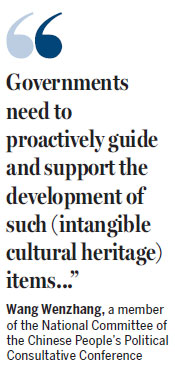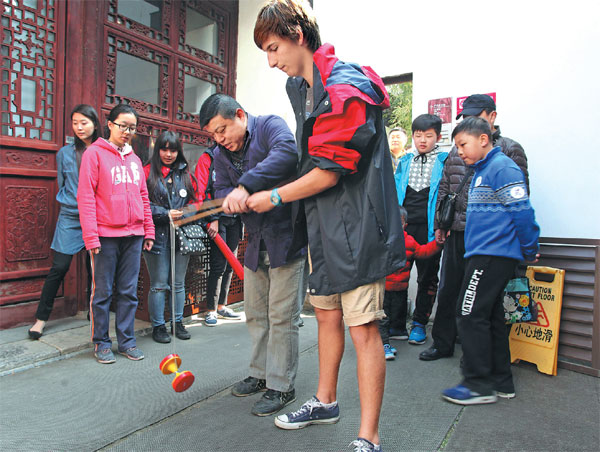Ancient culture improves the future
|
A foreign student learns to play kongzhu, a traditional Chinese game involving a bamboo ball, which was included among the first group of national intangible cultural heritage items in 2006, at a folkways museum in Nanjing, Jiangsu province. Provided to China Daily |
Protection, industrialization of intangible heritage discussed at two sessions
While China had identified 1,372 national-level intangible cultural heritage items and 13,087 provincial-level items as of 2016, insiders said their inheritance and protection have yet to be improved.
How to better protect and promote such items in modern times was among the hot topics discussed at this year's National People's Congress and the Chinese People's Political Consultative Conference in Beijing.
Together known as the two sessions, the annual meetings of China's top legislative and political advisory bodies were held earlier this month.
Feng Jicai, a CPPCC National Committee member, told Xinhua Daily Telegraph that integrating historic civilization into modern life is a cultural mission of contemporary society.
Pan Lusheng, also a national political adviser with the National Committee and president at the Chinese Folk Literature and Art Association, said that intangible cultural heritage retains a nation's essence and must be creatively incorporated into social changes and development to inspire changes in society.
Despite China's continuous efforts to strengthen protection of intangible heritage, historical preservation still faces such challenges as a lack of local protection mechanisms and a shortage of specialized funds, especially in remote regions where more attention was paid to filings than to effective protection, insiders said.
Wang Wenzhang, a CPPCC National Committee member, said protection of intangible heritage should not center around cultural relics, but should instead focus on using ancient culture to color modern innovation.
"Some items are fit for making new products," Wang said. "Governments need to proactively guide and support the development of such items and help to realize both economic and social benefits throughout their creation."
Pan, from the Chinese Folk Literature and Art Association, said that many intangible items are from impoverished areas inhabited by ethnic groups. He suggested the areas use their characteristic resources to strengthen the inheritance and conversion of traditional ethnic handicraft, protect culture and alleviate poverty.
Wang Jing, the only deputy to the National People's Congress in Guizhou province's Qianxinan Bouyei and Miao autonomous prefecture, brought 19 proposals to the two sessions this year.
She stressed the importance of ethnic culture in helping to advance poverty alleviation efforts.
"Women from areas inhabited by ethnic groups have many manual skills," Wang said, adding that if there are good policies and industries to support trade of intangible items, more of the women will have jobs with which to lift their families out of poverty.

The deputies' voices drew attention from other related authorities.
Sun Xing, vice-director at the industrial culture development center of the Ministry of Industry and Information Technology, said that the inheritance and protection of traditional handicrafts can be integrated with industrial development.
The ministry will support the construction of several cultural and creative parks, promote policy systems for development of related industries and found masters' workshops.
Cai Qun, a deputy from Guizhou province, proposed advice related to batik-style and embroidered textiles at the annual event.
She suggested more support be provided to rural small businesses, which can offer nearby villagers jobs and help popularize excellent ethnic culture.
Cai, who is from the Miao ethnic group, said the revenue of a Miao batik and embroidery company she founded in her hometown, Dazhai village, hit 8 million yuan ($1.16 million) last year and created jobs for more than 300 local women.
Guizhou, which boasts many intangible heritage items, launched a program in 2013 to promote the development of traditional ethnic handicraft industries.
The program is designed to create jobs for women who can embroider, helping to push the number of women in the province working in the handicraft sector to 500,000 by the end of 2016.
songmengxing@chinadaily.com.cn
(China Daily 03/16/2017 page17)















